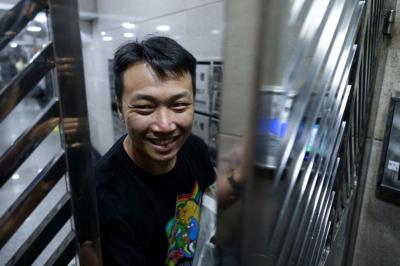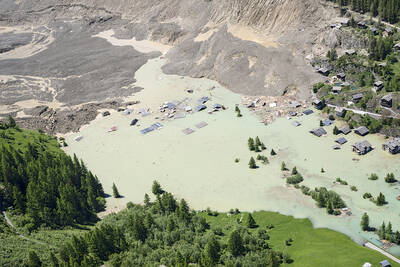Mexican forensic expert Alejandro Hernandez dips dry, yellowish cadavers in a see-through bath, hoping his technique to rehydrate mummified bodies will solve murders in crime-infested Ciudad Juarez.
The city bordering Texas has endured drug-related violence and a wave of murders of women in recent years, with bodies dumped anywhere and drying up quickly in the desert climate, complicating the task of identifying victims and their cause of death.
With his special solution, whose recipe he keeps secret, Hernandez can rehydrate bodies, making facial features as well as gunshot or stab wounds reappear.
“It is common with the climate in Ciudad Juarez … for bodies to mummify or stiffen, with the skin stretched like drums,” Hernandez, an expert at the Chihuahua State Prosecutor’s Office, told reporters. “It has always been a great satisfaction every time we were able to identify or determine the cause of death in the 150 cases that we participated in.”
The scientist has plenty of work on his hands.
Juarez became infamous in the 1990s, when hundreds of women were killed in an inexplicable homicidal binge that cast a dark shadow over the city.
The “femicides” were followed by a surge of violence between powerful drug cartels that left more than 10,500 people dead in the past six years.
Sometimes, victims are discovered in a mummified state years after they were buried, often making it impossible to identify them. This is where Hernandez comes in.
Techniques to rehydrate fingers to get fingerprints have existed for more than a decade, but Hernandez began using his method to restore entire bodies in 2008. He is currently seeking a patent to protect his secret method.
Elizabeth Gardner, a forensic science professor at the University of Alabama who saw a body treated by Hernandez, said that the “process works, the corpse was restored and looked like it could be identified from its facial features.”
“To the extent of my knowledge, this is the only method for rehydrating a corpse,” she said. “This technique will be most useful in dry areas, like Juarez. It’s labor — and materials — intensive, but it will be useful when other techniques fail.”
With the help of assistants in a lab that smells of death and chemicals, a cadaver is raised in a harness, gingerly lowered into the hermetically sealed bath and left to soak for four to seven days. Sometimes, technicians just dip a body part.
“We spin [the body] around the whole time until the human parts or the cadaver regain a more natural aspect,” Hernandez said. “Then you can observe moles, scars, blemishes, pathological or traumatic characteristics, which allow you to find the cause of death.”
Hernandez freezes decomposing bodies until they dry up and then he soaks them in his special bath.
“We are only doing this here in Ciudad Juarez,” he said, adding that the process is inexpensive.
The brutal drug war between the Sinaloa and Juarez cartels has waned in the past year, dramatically lowering the homicide rate in the city that was once the murder capital of Mexico.
However, bodies continue to pile up, with women still disappearing and human remains being discovered around the desert city of 1.3 million people.
Just this month, mothers of people who disappeared worked with the police to look for remains in a desert area near Juarez, and found bones they hope to identify one day.

Four people jailed in the landmark Hong Kong national security trial of "47 democrats" accused of conspiracy to commit subversion were freed today after more than four years behind bars, the second group to be released in a month. Among those freed was long-time political and LGBTQ activist Jimmy Sham (岑子杰), who also led one of Hong Kong’s largest pro-democracy groups, the Civil Human Rights Front, which disbanded in 2021. "Let me spend some time with my family," Sham said after arriving at his home in the Kowloon district of Jordan. "I don’t know how to plan ahead because, to me, it feels

The collapse of the Swiss Birch glacier serves as a chilling warning of the escalating dangers faced by communities worldwide living under the shadow of fragile ice, particularly in Asia, experts said. Footage of the collapse on Wednesday showed a huge cloud of ice and rubble hurtling down the mountainside into the hamlet of Blatten. Swiss Development Cooperation disaster risk reduction adviser Ali Neumann said that while the role of climate change in the case of Blatten “still needs to be investigated,” the wider impacts were clear on the cryosphere — the part of the world covered by frozen water. “Climate change and

Poland is set to hold a presidential runoff election today between two candidates offering starkly different visions for the country’s future. The winner would succeed Polish President Andrzej Duda, a conservative who is finishing his second and final term. The outcome would determine whether Poland embraces a nationalist populist trajectory or pivots more fully toward liberal, pro-European policies. An exit poll by Ipsos would be released when polls close today at 9pm local time, with a margin of error of plus or minus 2 percentage points. Final results are expected tomorrow. Whoever wins can be expected to either help or hinder the

DENIAL: Musk said that the ‘New York Times was lying their ass off,’ after it reported he used so much drugs that he developed bladder problems Elon Musk on Saturday denied a report that he used ketamine and other drugs extensively last year on the US presidential campaign trail. The New York Times on Friday reported that the billionaire adviser to US President Donald Trump used so much ketamine, a powerful anesthetic, that he developed bladder problems. The newspaper said the world’s richest person also took ecstasy and mushrooms, and traveled with a pill box last year, adding that it was not known whether Musk also took drugs while heading the so-called US Department of Government Efficiency (DOGE) after Trump took power in January. In a